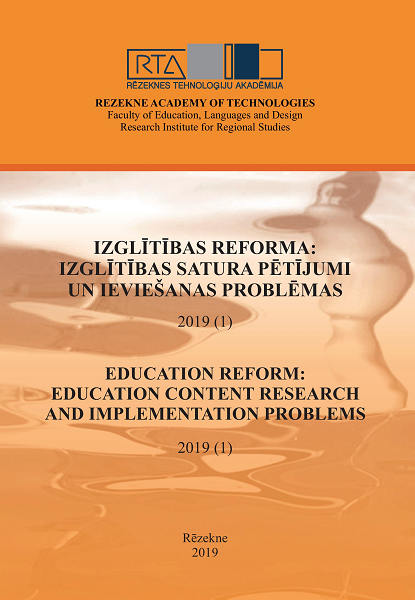STUDENT CREATIVITY AND ITS DEVELOPMENT IN VISUAL ARTS IN THE CONTEMPORARY EDUCATION SYSTEM
DOI:
https://doi.org/10.17770/er2019.1.4206Keywords:
art studios, creativity, fostering creativity, visual art, voluntary educationAbstract
The present paper looks at school age children’s creativity and the potential of its growth in the context of the contemporary educational system. In broad terms, visual art education in Latvia can be categorised in three categories: compulsory prescriptive, that every child has to learn in general schools, relatively voluntary in specialised art schools and voluntary in art studios. The paper draws on the practical experience of the author while teaching art in a studio that is voluntary in attendance. Through seven years of observation the author has found that children’s creativity grows the most when they are given tasks that inspiring fantasy and lack restrictive guidelines.References
Anspaks, J. (2004). Mākslas pedagoģija. 1. daļa. Rīga: RaKa.
Anspaks, J. (2006). Mākslas pedagoģija. 2. daļa. Rīga: RaKa.
Baltušīte, R. (2006). Skolotāja loma mācīšanās motivācijā. Rīga: RaKa.
Beļickis, I. (2000). Vērtīborientētā mācību stunda. Rīga: RaKa.
Beļickis, I.(2001). Izglītības alternatīvās teorijas. Rīga: RaKa.
Bereczki,E., Kárpáti,A. (2018). Educational. Research Review, 23, 25-53.
Čua, E. (2014). Tīģermātes cīņas himna. Rīga: Zvaigzne.
Doron. E. (2017). Fostering creativity in school aged children through perspective taking and visual media based short term intervention program. Thinking Skills and Creativity. 23, 150-160.
Jordan,J., Schwartz. H. (2018). Radical Empathy in Teaching. New Directions for Teaching and Learning, 25, 153-157.
Petre. G. (2018). Educating which creativity? Thinking Skills and Creativity, 27, 25-54.
Glăveanu P. (2018). Educating which creativity? Thinking Skills and Creativity, 27, 25-54.
Hall, J. (2010). Making Art, Teaching Art, Learning Art: Exploring the Concept of the Artist Teacher. International Journal of Art & Design Education, 12, 26-57
Helminga, H. (2006). Montesori pedagoģija. Rīga: Jumava.
Hibnere, V. (1998). Bērna vizuālā darbība. I daļa. Rīga: RaKa.
Hibnere, V. Grasmane, L. (2000). Bērna vizuālā darbība. II daļa. Rīga: RaKa.
Illeris, K. (2018). An overview of the history of learning theory. European Journal of Education, 75, 27 -29.
Kalgrēns, F. (2008). Valdorfa pedagoģija. Rīga: Jumava.
Karpova, Ā,(2011) Kreativitātes psiholoģija. Radošas personības psiholoģiskās īpatnības, RPIVA.
Keltikangasa-Jervinena, L. (2013). Augsta pašapziņa. Rīga: Zvaigzne.
Mākslas izglītība un kultūrizglītība Eiropas skolās - Eacea - Europa EU. Pieejams eacea.ec.europa.eu/education/EURYDICE/documents/thematic_reports/113LV.pdf
Ministru kabineta noteikumi Nr. 281. (2013). Noteikumi par valsts vispārējās vidējās izglītības standartu, mācību priekšmetu standartiem un izglītības programmu paraugiem. Rīga.
Ministru kabineta noteikumi Nr. 468. (2014). Noteikumi par valsts pamatizglītības standartu, pamatizglītības mācību priekšmetu standartiem un pamatizglītības programmu paraugiem. Rīga.
Ministru kabineta 2002.gada 15. augusta rīkojums Nr.436 Par Latvijas ilgtspējīgas attīstības pamatnostādnēm. Rīga.
Pestolocijs,J,H, (1998) Pedagoģijas studijas, 2.grāmata. Darbu izlase. Veltīta pedagoga 250.gadu atcerei, Rīga: LU
Pérez-Fabello,J, Campos, A. (2011). Dissociative experiences, creative imagination, and artistic production in students of Fine Arts. Thinking Skills and Creativity, 6, 45- 53.
SAC Skolu atbalsta centrs. (2000). Daudzpusīgā intelekta teorija skolā: pieredzes materiāls. Rīga: Skolu atbalsta centrs.
Samuseviča, A. (2000). Pētnieciskais process pedagoģijā. Mācību līdzeklis. Liepāja: LPA.
Sloane, D. (2005). Education and the Modern Assault on Being Human: Nurturing Body, Soul, and Spirit. Holistic Learning and spirituality in Education:breaking new ground. New York: University of New York Press.
Thornton, A. (2013). Artist, Researcher, Teacher: A Study of Professional Identity in Art and Education. Bristol: Intellect.
UNESCO. (2006). Konvencija par nemateriālā kultūras mantojuma saglabāšanu. Pieejams www.unesco.lv/files/KONVENCIJAlatviski2_99fc4d33.doc
Valbis, J. (2004). Skolēna personības attīstība – izglītības virsuzdevums. Rīga: Zvaigzne.
Williamson, K. (2011). The creative problems solving skills of arts and science students – the two cultures debate revisited. Thinking Skills and Creativity, 6, 30-45.






